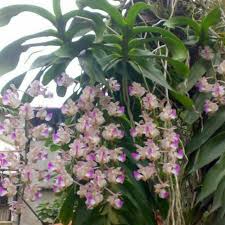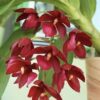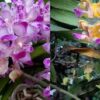# Renowned Artists Inspired by Quế Lan Hương (Dendrobium anosmum) Flowers

Quế Lan Hương, scientifically known as Dendrobium anosmum, is a tropical orchid celebrated for its stunning beauty and enchanting fragrance. Native to Southeast Asia, particularly in Vietnam, this flower has captivated not only horticulturists and plant enthusiasts but also artists, poets, and musicians throughout history. Its delicate petals and rich cultural significance have inspired a variety of creative expressions. This article delves into the lives and works of renowned artists who have drawn inspiration from Quế Lan Hương flowers, exploring how these orchids have influenced their art and contributed to their creative journeys.
## 1. The Allure of Quế Lan Hương
Before exploring the artists influenced by Quế Lan Hương, it is essential to understand the unique characteristics of this flower that make it such a source of inspiration:
### 1.1 Visual Beauty
Quế Lan Hương flowers are known for their stunning appearance. The blossoms come in shades of white, pink, and purple, often appearing in cascading clusters. Their graceful form and vibrant colors make them a favorite subject for artists, from painters to photographers.
### 1.2 Fragrance
One of the most distinctive features of Quế Lan Hương is its sweet, captivating scent. This fragrance is not only pleasant but also evokes emotions and memories, making it a powerful muse for creative minds.
### 1.3 Cultural Significance
In Vietnamese culture, Quế Lan Hương holds a special place. It symbolizes beauty, purity, and grace. The flower is often featured in traditional ceremonies and is associated with love and affection, providing a rich cultural backdrop for artistic inspiration.
## 2. Visual Artists Inspired by Quế Lan Hương
### 2.1 Nguyễn Gia Trí (1908-1993)
Nguyễn Gia Trí was a prominent Vietnamese painter known for his innovative use of lacquer art. His works often reflect the natural beauty of Vietnam, with Quế Lan Hương flowers frequently appearing in his paintings.
– **Artistic Style**: Trí’s lacquer paintings are characterized by vibrant colors and intricate details. He skillfully captures the essence of Quế Lan Hương, highlighting its delicate petals and graceful form.
– **Inspiration**: Trí drew inspiration from the natural landscape of Vietnam, incorporating local flora, including Quế Lan Hương, into his compositions. His works celebrate the beauty of Vietnamese culture and nature, making him a key figure in the development of modern Vietnamese art.
### 2.2 Trần Văn Cẩn (1910-1994)
Trần Văn Cẩn was another influential Vietnamese painter and a founding member of the Vietnam Fine Arts Association. His works often depict traditional Vietnamese themes, including landscapes and flora.
– **Floral Representations**: Cẩn frequently included Quế Lan Hương in his floral compositions, emphasizing the elegance and grace of the flower. His ability to convey the beauty of nature through his art has left a lasting impact on Vietnamese painting.
– **Cultural Connection**: By incorporating Quế Lan Hương into his work, Cẩn not only showcased the flower’s beauty but also highlighted its significance in Vietnamese culture, reinforcing the bond between nature and artistic expression.
### 2.3 Đặng Xuân Hòa (b. 1951)
A contemporary Vietnamese artist, Đặng Xuân Hòa, has gained recognition for his vibrant and dynamic paintings that often feature Quế Lan Hương.
– **Innovative Techniques**: Hòa employs mixed media and bold colors to capture the essence of Quế Lan Hương, creating a modern interpretation of this classic flower. His works evoke emotion and convey a sense of movement, making the flowers appear almost alive.
– **Personal Reflection**: Hòa’s art reflects his personal connection to nature, and Quế Lan Hương serves as a central motif in many of his pieces. His ability to blend traditional themes with contemporary techniques has garnered him international acclaim.
## 3. Photographers Inspired by Quế Lan Hương
### 3.1 Nguyễn Thành Công
Nguyễn Thành Công is a renowned Vietnamese photographer known for his stunning floral photography. His work often highlights the beauty of Quế Lan Hương, capturing its delicate details and vibrant colors.
– **Photographic Style**: Công’s photography focuses on macro shots that emphasize the intricate features of Quế Lan Hương flowers. By using natural lighting and close-up techniques, he creates images that evoke emotion and appreciation for nature’s beauty.
– **Environmental Advocacy**: Through his photography, Công raises awareness about the importance of preserving natural habitats for flowers like Quế Lan Hương. His work serves as a reminder of the fragility of nature and the need to protect it.
### 3.2 Lê Bảo
Lê Bảo is a contemporary photographer whose work often explores themes of nature and identity. Quế Lan Hương flowers appear in many of his projects, symbolizing beauty and resilience.
– **Narrative Photography**: Bảo’s approach to photography combines storytelling with artistic expression. He uses Quế Lan Hương as a motif to convey deeper messages about cultural heritage and the connection between nature and human experience.
– **Cultural Exploration**: By incorporating Quế Lan Hương into his work, Bảo highlights the significance of this flower in Vietnamese culture and its role as a source of inspiration for artists and individuals alike.
## 4. Poets and Writers Inspired by Quế Lan Hương
### 4.1 Tố Hữu (1920-2002)
Tố Hữu is one of Vietnam’s most celebrated poets, known for his impactful verses that often draw inspiration from nature, love, and the struggles of the Vietnamese people.
– **Poetic Imagery**: In his poetry, Tố Hữu frequently references Quế Lan Hương, using the flower as a symbol of beauty and resilience. His verses capture the essence of the flower, evoking vivid imagery that resonates with readers.
– **Cultural Significance**: Through his poetry, Tố Hữu emphasizes the cultural importance of Quế Lan Hương, connecting it to themes of love, nostalgia, and the beauty of life. His ability to weave nature into his work has left a profound impact on Vietnamese literature.
### 4.2 Xuân Diệu (1916-1985)
Xuân Diệu, known as the “Prince of Poets,” is another influential figure in Vietnamese literature. His poetry often explores themes of love and the fleeting nature of beauty, making Quế Lan Hương a fitting symbol in his works.
– **Symbol of Transience**: Diệu uses Quế Lan Hương to represent the ephemeral nature of love and beauty. His verses reflect a deep appreciation for the flower’s elegance while acknowledging the transient nature of life.
– **Emotional Depth**: Through his poetic expressions, Diệu captures the emotional depth associated with Quế Lan Hương, making it a powerful symbol in his exploration of love and longing.
## 5. Musicians and Composers Inspired by Quế Lan Hương
### 5.1 Phạm Duy (1921-2013)
Phạm Duy was a prominent Vietnamese composer and songwriter known for his romantic ballads and folk music. His songs often reflect themes of love and nature, with Quế Lan Hương serving as a recurring motif.
– **Musical Imagery**: In his compositions, Duy incorporates references to Quế Lan Hương, using the flower to evoke feelings of love and nostalgia. His lyrics often draw on the beauty of nature, creating a deep connection between music and the natural world.
– **Cultural Heritage**: By featuring Quế Lan Hương in his music, Duy emphasizes the cultural significance of the flower and its role in Vietnamese traditions, making his work resonate with audiences.
### 5.2 Vũ Thành An (b. 1943)
Vũ Thành An is a celebrated composer known for his poignant love songs. His music often reflects the beauty of nature, with Quế Lan Hương playing a significant role in his lyrical themes.
– **Emotional Resonance**: An’s songs frequently feature metaphors related to Quế Lan Hương, capturing the essence of love and beauty. His ability to weave nature into his music creates a rich emotional experience for listeners.
– **Legacy of Love**: Through his compositions, An highlights the enduring beauty of Quế Lan Hương, reinforcing its significance in Vietnamese culture and its ability to evoke deep emotions.
## 6. The Legacy of Quế Lan Hương in Art and Culture
The influence of Quế Lan Hương extends beyond individual artists; it represents a broader cultural appreciation for nature and its beauty. The flower has become a symbol of Vietnamese identity, serving as a muse for countless creative expressions.
### 6.1 Cultural Festivals
Quế Lan Hương is often celebrated in cultural festivals across Vietnam, where artists, musicians, and poets come together to showcase their work inspired by the flower. These events highlight the importance of preserving cultural heritage and fostering artistic expression.
### 6.2 Artistic Collaborations
Collaborations between artists, musicians, and writers centered around Quế Lan Hương continue to thrive, reflecting the flower’s enduring significance in contemporary art and culture. These collaborations serve to bridge different forms of artistic expression, creating a vibrant tapestry of creativity.
## 7. Conclusion
Quế Lan Hương is more than just a beautiful flower; it is a source of inspiration for a diverse array of artists, musicians, and writers. From visual artists like Nguyễn Gia Trí and Trần Văn Cẩn to poets like Tố Hữu and musicians like Phạm Duy, the influence of Quế Lan Hương permeates various artistic disciplines.
The enduring beauty and cultural significance of this orchid continue to inspire new generations of creatives, ensuring that Quế Lan Hương remains a beloved symbol of nature’s artistry. As artists draw from the flower’s grace and
charm, they contribute to a rich legacy that celebrates the interconnectedness of nature, culture, and creativity. Through their work, the essence of Quế Lan Hương will continue to bloom in the hearts and minds of people for generations to come.

